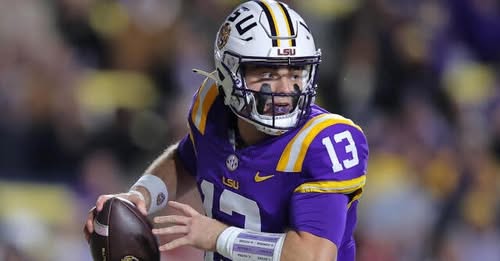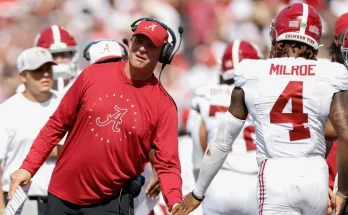Purple and Gold Reign Supreme: Why LSU’s Iconic Colors Stand Alone in College Football
In a sport defined by tradition, identity, and pageantry, college football teams often rely on more than just wins and losses to etch their names into history. Helmets, uniforms, chants, mascots — every element of a program is a reflection of its spirit. But for the LSU Tigers, nothing captures the essence of their identity more than the vibrant, unmistakable pairing of purple and gold. Across stadiums, TV screens, and tailgate parties from Baton Rouge to beyond, the color combo isn’t just eye-catching — it’s iconic. And there may be no stronger argument in college football: there simply isn’t a better color combination in the game.
Purple and gold don’t just look good together; they mean something. These colors represent the pulse of Louisiana, a culture where pride and flair go hand in hand, where loyalty is thick as gumbo and Saturdays in the fall feel like holidays. From the first whistle of the season to the final roar of Tiger Stadium, purple and gold don’t just show up — they take over. They’re as much a part of LSU football as the team itself, and for fans, they’re a badge of honor worn with unwavering devotion.
There’s something regal about purple — historically the color of kings, queens, and warriors. It’s rare in college football, which makes it stand out in a sea of red, blue, and green. Gold adds a championship-level glint, radiating energy, intensity, and flash. Together, the colors create a visual symphony that mirrors the style of play LSU has become known for: aggressive, fast, electric, and unapologetically bold. The Tigers don’t just play football — they make a statement doing it, and the uniform colors are the exclamation point.
For players, slipping on the LSU jersey isn’t just about representing a school; it’s about stepping into a legacy. Every time an athlete dons that purple and gold, they’re walking in the footsteps of legends — from Billy Cannon to Joe Burrow, from Patrick Peterson to Ja’Marr Chase. The uniform ties past to present, legacy to future. It’s a reminder of the expectations, the history, and the unrelenting spirit of Tiger football. That deep purple jersey with gold accents isn’t just a look — it’s a responsibility.
The LSU brand has been bolstered nationally by these colors. Whether it’s a Saturday night under the lights at Death Valley or a marquee bowl game on New Year’s Day, the second those uniforms hit the field, you know who you’re watching. That recognition — that instant brand awareness — is the holy grail of college athletics. Very few programs can claim it, but LSU owns it outright. You don’t need a scoreboard or a broadcaster to tell you what team is playing when you see the gold helmets gleaming under stadium lights. You just know.
And then there’s Tiger Stadium — Death Valley — the mecca of college football atmospheres, made all the more intimidating by a wall of fans draped in purple and gold. It’s not just a crowd. It’s a force. The color combo contributes to the mystique of the venue, adding layers to the sensory overload that visiting teams experience. When 100,000 fans are unified not just in voice but in color, it’s a psychological advantage that cannot be overstated. It’s hostile, it’s loud, and it’s beautiful.
What sets LSU’s color palette apart is how it translates across all mediums. On TV, purple and gold pop more than nearly any other uniform in the sport. In photography, the richness of the colors jumps off the page. In merchandise, the contrast and vibrancy are unmistakable. LSU apparel doesn’t just sell — it sells well, and it’s easy to see why. Whether it’s a crisp home jersey, a throwback alternate, or a simple hoodie, the blend of royalty and energy screams excellence.
The marketing side of LSU Athletics understands this power. Every piece of branding — from posters to social media graphics to billboards — leans heavily into the purple and gold aesthetic. It’s more than just color; it’s identity. It’s also unity. Every Tiger fan, whether a lifelong Louisianan or a freshman from out of state, immediately becomes part of the fabric when they wear those colors. It’s a connector, a symbol of pride, and a shared language spoken loudly on game days.
In recruiting, LSU’s branding edge is significant. When a high school athlete visits Baton Rouge and walks into Tiger Stadium, it’s not just the facilities or the coaching staff that impresses — it’s the feeling. The visuals are striking, the energy palpable. Many athletes choose programs based on how they see themselves fitting into a culture. For many, that moment comes when they picture themselves in those LSU colors, with the gold helmet gleaming under the lights, hearing the roar of the Tiger faithful. Purple and gold isn’t just a combination. It’s a dream.
Even outside of football, the LSU color scheme continues to shine. From baseball to gymnastics, from women’s basketball to track and field, LSU athletes carry the torch across sports and seasons. And no matter the venue, the presence of those colors always feels imposing, proud, and elite. They bring a sense of gravity, a recognition that LSU is never just participating — they’re contending.
Of course, many programs boast about their colors. Michigan has maize and blue, Texas has burnt orange, Oregon has every shade of green under the sun. But what makes LSU unique is the combination of timelessness and freshness. Purple and gold is not a trendy color scheme — it’s a classic one, but it’s also remarkably versatile. It works on throwbacks, alternates, monochromes, and even custom cleats. Few schools can say their colors look as good on a vintage jersey as they do on a futuristic alternate — LSU can.
It’s not just about colors looking good — it’s about how they feel. And purple and gold feels like power. It feels like pride. It feels like the state of Louisiana. That deep, rich purple reflects the roots of the bayou, the strength of its people, and the defiance of a state that often finds unity through football. The gold evokes fire, passion, and glory — the essence of championship ambition. It is no coincidence that LSU often rises to the occasion on the biggest stages. With those colors stitched across their chests, the Tigers look like they belong — because they do.
This isn’t just subjective praise. From design experts to fans across the country, LSU’s uniforms consistently rank among the most visually stunning in all of college football. Uniform rankings, color popularity polls, and social media engagement numbers back up the claim: LSU’s look is elite. In an age where brands battle for eyeballs and attention, LSU’s consistent visual identity stands tall — and that identity is rooted in two unforgettable colors.
So when fans say there’s no better color combo in college football than purple and gold, they aren’t speaking from bias — they’re speaking from a truth that’s hard to deny. It’s a truth built over decades of dominance, tradition, and excellence. It’s a truth reinforced by images of confetti falling in national championship games, of Heisman winners hoisting trophies, of generations of Tigers running out of the tunnel to a sea of color and noise.
Purple and gold are more than colors. They’re culture. They’re history. They’re LSU.
And in the ever-changing world of college football, where conferences shift and rosters turn over and stadiums grow bigger, that color combo remains one of the game’s most iconic constants — bold, brilliant, and forever tied to greatness.



